ENTER YOUR EMAIL TO RECEIVE OUR WEEKLY NEWSLETTER
Rooms With a View in France: Aligned by the Stars
Hotel-ranking stars, that is, in Paris and points south
By Stacia Friedman
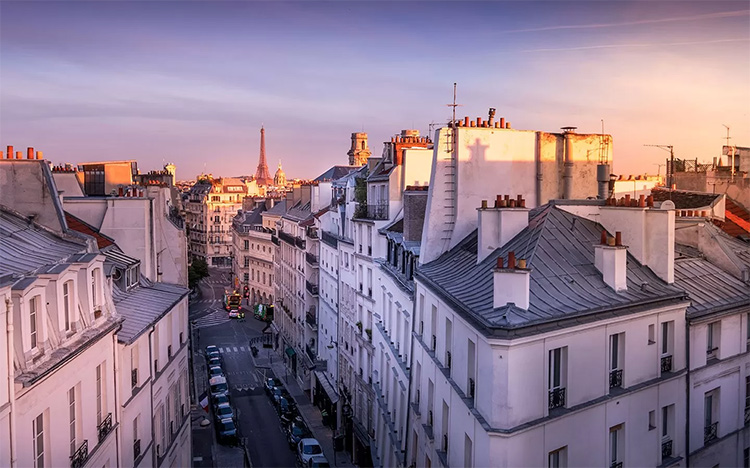
Sighting: From a window of the Hotel Trianon Rive Gauche, with the Eiffel Tower looming ahead.
. . . . . . . . . . . . .
March 1, 2024
As a travel writer, I have stayed at hotels with rankings from zero to five stars, plus a few so glam, they merited their own solar system. But during a recent trip to Paris and points south, I decided to experience a variety of options, as if dining at a mega-buffet.
Other than watching “Call My Agent” on Netflix, I had not been to France, or anywhere more foreign than Ikea, in over six years now. For one thing, there was the lockdown. And medically, I fall into the category of those for whom a diagnosis of Covid could trigger a visit to the ICU. But when my doctor finally urged me to get out of town, I followed her orders to the letter and booked a flight.
While others may choose a unique destination each time they travel, I invariably return to France. When I am there, all my puzzle pieces fit together, and stress melts away with the first spoonful of crème brûlée. On each visit, in addition to stopping in Paris, I explore spots in the hinterlands. And this time, while I aimed for the region of France that many consider to be the best—Provence!—I only partially succeeded: Just one of the four hotels I stayed at wound up being in that southeastern region of France. But I accomplished another goal I’d set out for myself—scrutinizing each hotel for its star ranking.
Experience has taught me that the French hotel ranking system is no more reliable than age, height, and weight on online dating sites. So what do those stars actually mean?
One-star rankings are based solely on minimal square footage in the guest rooms and a staff who only speak French. Hotels assigned a solo star also have no elevator, no AC, and as for bathrooms—they may be shared. Two-star hotels may also have tiny rooms, but some come equipped with private bathrooms, and if five or more floors are involved, you can expect an elevator. Three-star hotels must have private bathrooms, a help-yourself bar in the lobby plus an elevator with four or more floors. And yet a two- or three-star hotel can have incredible charm, a congenial staff, and a dynamite location.
Luxury comes into play with hotels having four stars—which mean larger rooms, private baths, elevators, WiFi, AC, full concierge services, a generous breakfast buffet, and an English-speaking staff. These days, they may offer spas, a fitness room, an indoor swimming pool, and other amenities.
Five-star hotels contain all of the above, along with even larger rooms, an onsite restaurant, room service, and still more amenities. At the high end of five-star hotels are “palace” hotels offering Michelin-starred restaurants. There are only eleven such hotels in Paris, including the Plaza Athénée, Le Meurice, and George V. For details, go to the Paris tourism office.
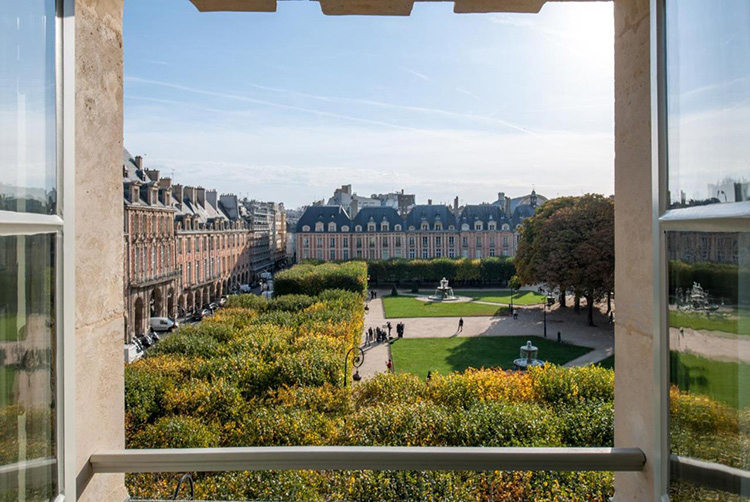
Wide-angle view: The Place des Vosges, from the Cour des Vosges.
. . . . . . . . . . . . .
Since my idea of luxury is a boutique hotel in a drop-dead location, I chose the 5-star Cour des Vosges, situated on the regal Place des Vosges, where Victor Hugo wrote his novels. With just a dozen posh rooms and suites, each with floor-to-ceiling views of the historic 17th century square it’s on, this qualifies as the smallest luxury hotel in Paris. Rooms start at $750.
Arriving from Philadelphia jet-lagged and famished, I wasn’t sure which to throw myself upon first—the sumptuous bed, the complimentary gourmet munchies, the top-shelf bar, or the adorable concierge. I wisely chose the bed, enfolding myself in butter-soft sheets that could put Ambien out of business.
While this was not my first experience at a 5-star hotel, it was my giddiest. From luxe beauty product samples which promised to remove the bags under my eyes, to the wooden shutters and blackout curtains that made sleep an option at any hour, I felt totally coddled and rejuvenated. And what is more pleasurable than walking out the front door and finding yourself in the Marais, the former Jewish quarter, now an LGBTQ nightlife hotspot, filled with intriguing shops and cafes?
The next morning, I took the three and a half hour high-speed TGV to Nîmes (which, technically, is not in Provence, but in the Occitane region). An outpost of the Roman Empire, Nîmes retains many of its ancient buildings. It also has elegant 18th and 19th century boulevards reflecting its historic prosperity as a textile-manufacturing city. This is the city that gave the world denim—its name derived from serge de Nîmes (serge meaning “sturdy fabric” and denim, a contraction of de-Nîmes). For travel details, go to the Nîmes tourism office.
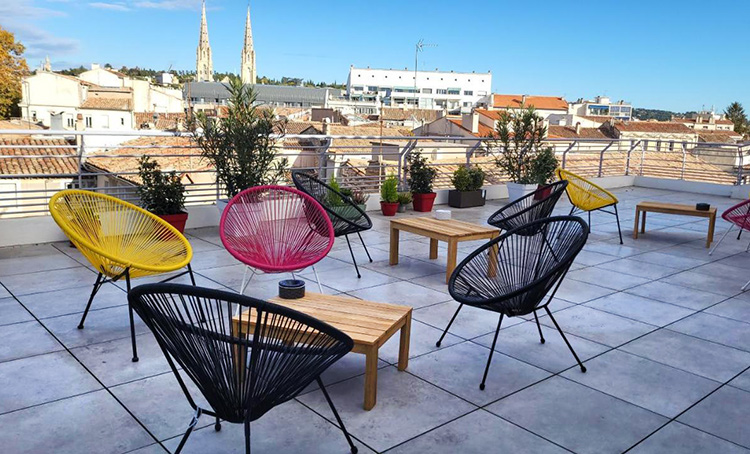
Overlooking Nîmes: Al fresco breakfasting on the roof of the Square Hotel.
. . . . . . . . . . . . .
I stayed at the 3-star Square Hotel. Whatever it lacked in glitz, it made up for in its friendly staff, cleanliness, comfort, and convenient location, not to mention a rooftop breakfast room with a DIY cappuccino machine. It’s three-, rather than four-star ranking, was due to the size of the rooms and the lack of a bar in the lobby, as well as an absence of other amenities. Rooms start at $75 per night.
I had no complaints! The Square ticked off my location requirements, placing me within walking distance of the ultra-modern Musée de la Romanité, known for its in-depth range of Roman antiquities and, on its top floor, a Michelin-ranked brasserie, La Table Du 2, with a breathtaking view of Nîmes’ Roman arena, circa 1 A.D. From there, it was an easy sprint to the Maison Carrée, a beautifully preserved 1st century Roman Temple, and the 17th century Jardins de la Fontaine, which combine the finest elements of French landscaping and Mediterranean plants.
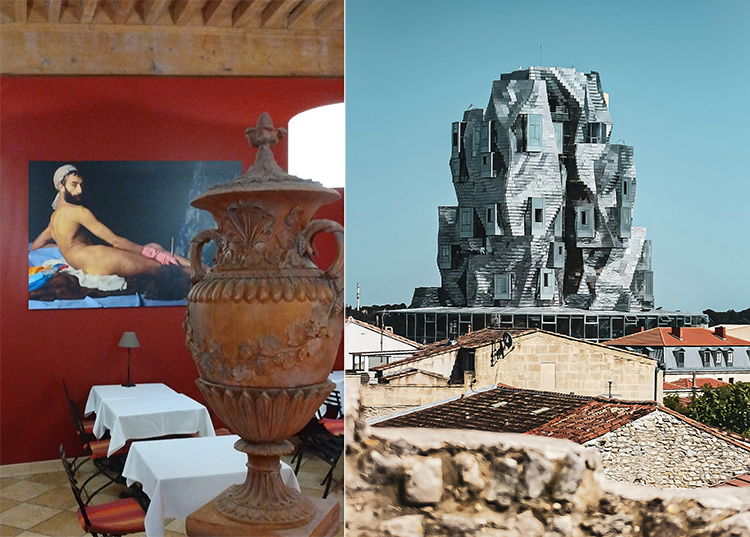
Ode to Odalisque: A takeoff of the Ingres nude in the breakfast room of the Hotel de l’Amphitheatre in Arles. Photo by Stacia Friedman. View of the Frank Gehry-designed LUMA Arles museum. Photo by Baptiste Buisson/Unsplash.
. . . . . . . . . . . . .
My final destination finally brought me to Provence—Arles, specifically. On my arrival, I encountered a brass band, decked out in snappy red and gold uniforms. For me? Hardly. The band was announcing the start of a bullfight in the ancient Roman arena. While I was relieved to know bulls are not killed for sport in Arles, they did appear on restaurant menus. I did not attend the event or order a bull burger, but I was entranced by the women in traditional Provencal garb—lace shawls and floor-length gowns—and men sporting wide-brimmed black hats. For travel details visit the Arles tourism office.
The 3-star Hotel de l’Amphitheatre, where I stayed, a converted 17th century mansion of unparalleled elegance, was situated on a narrow street that Van Gogh might have sketched. Inside, a red color scheme prevailed, and a life-size photograph of a naked man holding a feather duster was prominently displayed in the breakfast room. I was puzzled until I realized it was a wink at Ingres’ Odalisque. Rooms start at $89.
So why only three stars? As I lugged my suitcase up a marble staircase, it hit me. No elevator! Yet my room was as large as in any 5-star hotel, ditto the size of the bathroom, outfitted with a soaking tub and fluffy robes. The English-speaking hotel manager was a charmer, and the hotel was just footsteps from everywhere I wanted to go. That included a visit to the contemporary Frank Gehry LUMA Arles museum, a tour of the Van Gogh Trail (the walking route that inspired the artist’s landscape paintings), and stopping at shops for Provencal textiles, lavender sachets, and eau de toilette. In retrospect, my Arles hotel was a 4-star in every way but one—ascension.
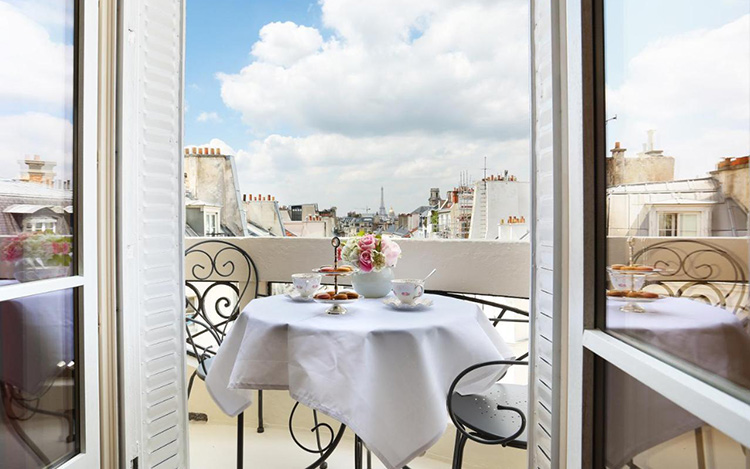
Petit déjeuner à Paris: At the Hotel Trianon Rive Gauche.
. . . . . . . . . . . . .
Which brings me to the 4-star Hotel Trianon Rive Gauche back in Paris—my final stop before returning home. Since I have a preference for small hotels, my expectations for this 110-room behemoth were dim. But somehow, despite its size, it delivered all the perks of a boutique hotel. The lobby was warm and inviting, with cozy seating and complimentary afternoon tea. The concierge provided for guests’ needs, from finding misplaced room keys to making hair salon appointments. (Guilty on both counts!) My room was smaller than those in the 3-star hotels in Provence—but this was Paris, which, like New York, is always a tight squeeze. Plus, I had a view of the Eiffel Tower and was footsteps from the Luxembourg Gardens and the cafes of Saint-Germain-des Prés. Rooms start at $170.
In retrospect, the difference between three- and four-star hotels in France is in the eye of the beholder. My advice? Do not select a hotel by its star rating, price, or online reviews alone. Contact the tourist board of every city you plan to visit and make your priorities clear. This worked for me! Tourist boards are also your best online sources for free info about dining, concerts, museums, events, and tours. More importantly, staffers at these boards live, dine, and shop in the city you are visiting and, unlike third-party online booking sites, do not profit from their recommendations.
Stacia Friedman is an award-winning freelance journalist who writes for regional and national publications.











